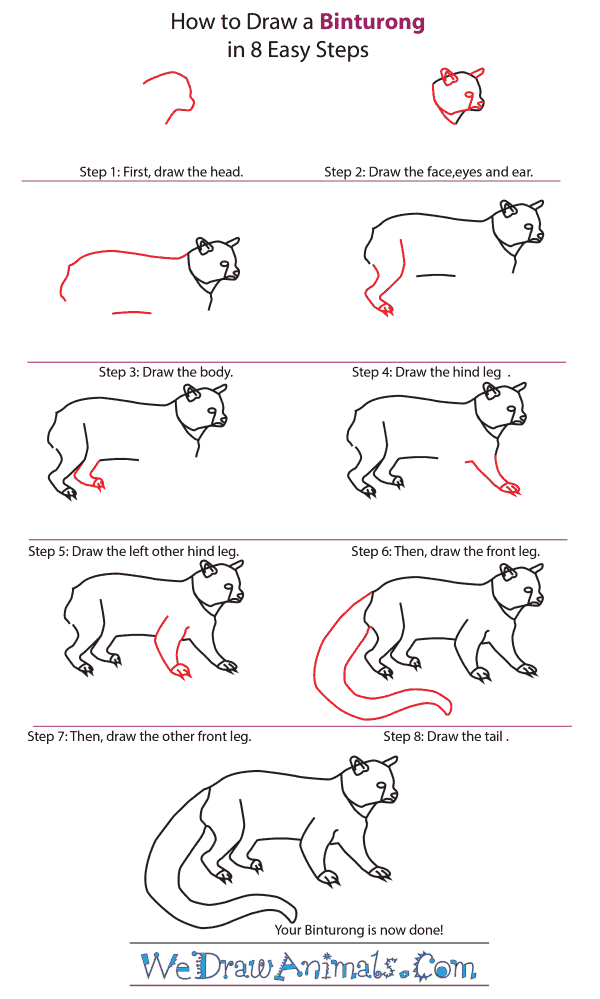In this quick tutorial you'll learn how to draw a Binturong in 8 easy steps - great for kids and novice artists.
The images above represent how your finished drawing is going to look and the steps involved.
Below are the individual steps - you can click on each one for a High Resolution printable PDF version.
At the bottom you can read some interesting facts about the Binturong.
Make sure you also check out any of the hundreds of drawing tutorials grouped by category.
How to Draw a Binturong - Step-by-Step Tutorial
Step 1: First, we draw the head of the Binturong. It is shaped like a closed fist. Make sure to bump out one spot on the side.
Step 2: The binturong is also called a bearcat. Draw pointy cat like ears. Give it a small oval for the eye with a line going down to the chin. Now draw a triangle for the nose. Add a line going from the back of the head to the nose, and another that separates the head from the neck.
Step 3: Draw the body. The top line gently curves downward, with a small point at the rump. Make a straight line at the bottom, leaving space for the legs.
Step 4: These animals spend lots of time climbing and living in trees, so they have small, strong legs with sharp claws. Draw two curved lines for the hind leg leading into the foot. Add the claws.
Step 5: The other hind leg comes next. It is two L shapes coming down into the foot. Add claws on this foot too.
Step 6: You're an expert at the legs now! The front is the same, the lines are just a little straighter.
Step 7: Onto the last leg. Two more straight lines leading down into a foot with claws.
Step 8: Last, draw the tail with some wavy lines. The tail is very long, helping the binturong stay balanced up in the trees it calls home. To add details, the binturong has shaggy black or brown fur and whiskers.
Interesting Facts about the BINTURONG
The Binturong is a member of the mammal family and the scientific term for them is Arctictis binturong. Their Latin name Arctictis is derived from the Greek language, bear (Arkt)-weasel (iktis). Another common name for this animal is the Bearcat, since their appearance is similar to both a bear and a cat.
Did you know?
- The animal was first documented in 1822.
- They can grow up to almost 3 feet long.
- Their tail can be over 2 feet long.
- The females are about 20 percent larger than the males.
- These animals can weigh up to over 71 pounds.
- They are found in heights of almost 4,000 feet above sea level.
Their habit is more closely related to the cat, since they are mostly mobile during the day and night, climbing a lot, usually trees, and sleeping above the ground. They have a wide body with thick black hair. The big face and small ears are round, and the nose is turned up at the end. Their bushy tail can wrap around tree branches like a monkey, and they only live in tall forests. This species is often captured and domesticated for use as a pet, but they are temperamental. Since there are so few of these creatures, they are vulnerable to extinction.









